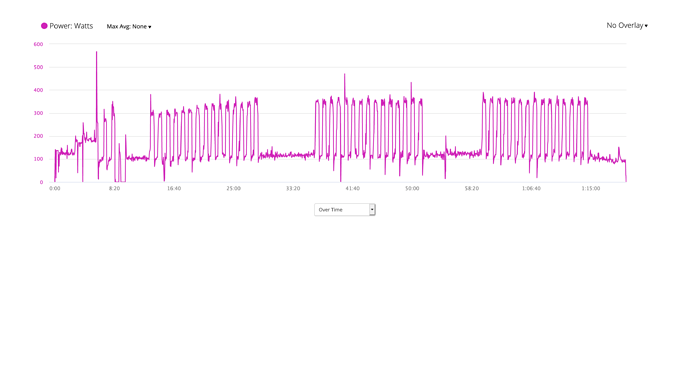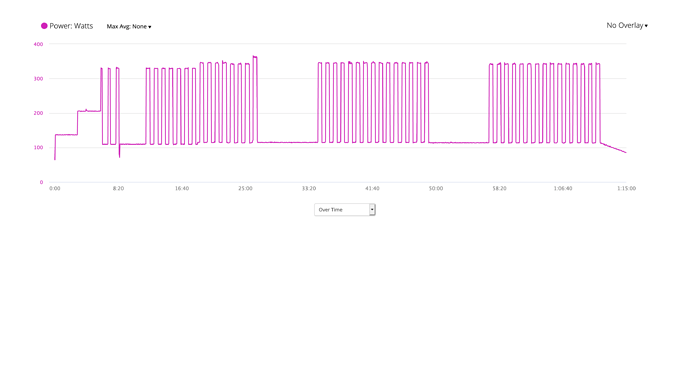After some time adjusting going from 39/19 to 53/15, my cadence has dropped, also feel i use my leggs more (got a few days of stiffness). But my FTP seems the same.
I use Tacx NEO
I do feel that higher gear is more right for me. Outdoors i have about same watts on flats as in climbs (I think).
To add to your statement, can you tell us if you’re typically better at climbing or riding on the flat relative to others you size and power?
I just did set my venge up on my neo 2 to be able to compare my outdoor vs indoor watts and it turns out the s-works power cranks are consistently reading 10-12 watts higher on the small ring and 18-20 watts on the big ring.
I suppose it’s to be expected for the trainer measure a lower wattage. Did you guys experience something similar?
Varied power measurement from low flywheel to high flywheel speed is documented on a couple of trainers. The Neo (not sure the specific models proven) and H3 for sure. I can link to videos showing the testing and data (from Tariq Ali and Shane Miller from what I remember).
So, it’s a known issue that faster flywheel speed leads to divergence from “real” power meters on at least some trainers (and pretty likely more).
Thank you for the quick answer. I watched the video but was suprised still the difference is this big. 20 Watt is quite significant.
So it’s been reported by a few here that training exclusively in the big ring negatively affected their real world climbing ability, but what about the opposite? What if I’m training specifically for triathlons with pancake flat bike portions, any negatives to training exclusively in the small ring indoors?
N=1 for me:
- I trained 75% or more in the 34x17 combo the last 3 seasons on TR.
- I do add plenty of standing breaks at 50x17 for comfort and to change muscle loading.
- I also using 50x17 (and similar ratios) for “low cadence / high force” work to replicate climbing.
And despite that “low inertia” focus, I have had increasingly good results on the bike legs of my duathlon events. I also had decent results in my road events (other than some bad strategy decisions in one) in the same time periods.
I am experimenting a bit more this winter (spurred from these discussions) and trying more high flywheel speed training. I can’t make any claims other than I can “tell a difference” in the feel of the differences. I don’t know if there is any “negative” from the low speed training for high speed users. Pretty impossible to know without more good data or personal experience, unfortunately.
I can’t say that I feel I am missing anything specifically, but I am experimenting to see if I notice any differences rolling into this season.
Edit to add: I am 5’-10" and 145 lbs on a “loaded” day (about 3.9 w/kg), so that likely impacts my experience inside and outside.
This topic seems to be very personal and individual. Personally I think you should experiment and go with what feels right.
FWIW out the door for 6+ months of the year it is pancake flat but brutal headwinds, my favorite training route and weekly Wed night worlds feel like a 60 minute climb in the nearby mountains. And on Wed night when fitness is high I usually put out more power on the tailwind return. I’ve had very good success using large chainring on the trainer, for both these flat/windy rides and long climbs (1-3 hours) in the Sierra mountains.
+1
I exclusively train on small ring (36) on TR, mid-cassette on the rear. Only to limit noise and vibration (Wahoo Kickr). I am a all-rounder rider, like to climb, like to put big watts on the flat as well. Feel VERY comfortable on steady pace efforts outdoor at 85/90% FTP, including on flat.
Don’t know if it is related to training on small ring indoor, but I like low cadence a lot outdoor. I train around 90-95 indoor on TR, but most of the time around 70-75 outdoor, even on flat section. Feel like I try to find the same kind of resistance with big gearing on the road. If it’s ok to be above 90rpm for me on TR, I feel like I loose “control” on the road above 85rpm. Weird.
Regarding numbers, my outdoor FTP/abilities follow(s) the same curve as my indoor FTP, no matters the gradient, etc
Yes, I noticed that.
Slightly different muscle utilization.
I would switch to the big ring. It’ll take a few sessions to get used to.
Yeah, it makes sense to train to your most relevant strengths
What I’ve noticed with the Wahoo Kickr and Vector 3 dual sided peddles.
10 min warm up then perform a spindown calibration, and calibrate the peddles.
Today I was doing taylor -1, so VO2 intervals with the peddles on the garmin, trainerroad on the kickr. The warm up and first 2 intervals (of the first set) are on the big ring, from there swapped to the small ring as the power was 10% down, target 330, actual 300ish. Dropping to the small ring actually made things worse initially.
What you do see from the data though is that as the trainer warms up the 2 power meters gradually come back into line, after 26 minutes riding time they’re both reading almost exactly equally. My surprise here is how long and how hard you have to work it before the trainer warms up. I’ve felt something was a bit out now for a while, looks like it’s solved.
Thursday is SS, so I’ll do some back to back with big and little chain ring there.
A lot of the data here relies on the assumption that trainers measure power in a consistent manner regardless of spindle speed - a pretty large leap of faith. I have a lot more faith in the tests that include an independent power meter than those which don’t.
Given all this (ie flywheel speed affecting power accuracy) it’s hard to see how most trainers meet their claimed accuracy. I have not seen any statements from a trainer manufacturer that details what testing methodology they use to generate these claimed accuracy numbers, but it’s clear that some of them do not include testing a range of flywheel speeds.
Elite trainers, Drivo, Direto, and Suito (not positive on this model) are only trainer that actually uses a power meter (optical). They use a German laboratory Physikalisch-Technische Bundesanstalt (PTB) for testing and certification of their accuracy claims, see Elite Drivo Trainer In-Depth Review | DC Rainmaker. Wahoo gen 1 had a stain gauges but they had problems.
I use the small ring in the middle of the cassette. I have completed 3 ramp tests with this now, I am considering moving to the big ring, for erg work outs now. For a ramp test, shall I always keep them in the small ring now?
I am thinking of moving to the big ring for more of a road feel, and helps with my cadence. Plus this helps with wear and tear on my gearing.
Ramp test with what gearing you want to do the ERG workouts in. If I do a ramp test in Big Gear, then my FTP is 15 watts higher than if I did ramp test in Small Gear. YMMV for you if you do a ramp test both ways. In the end - keep your workouts and ramp test on same gear (Big vs Small) so you get the stimulus you are looking for without undershooting/overshooting FTP. Also, I would recommend Small Gear if you training for MTB. It will make a difference since we have less inertia in MTB.
Thats what I thought…I noticed a few watt increase when using the big ring. I don’t want to over shoot my FTP. I mean I want an increase but I want to be able to finish work outs.
The small ring is also quieter. Would using the big ring in work outs be more “realistic” feel though?
It can be very individual, with my Kickr 2017 direct-drive I’ve found big ring to give the most realistic feel and allows using the same FTP inside and outside. You need to experiment and find out for yourself. If you decide to switch from little to big ring, then I would recommend a new ramp test in big ring just in case you have different FTPs (little vs big).
That was my decision. I would rather train in Small Gear for MTB rather than have a larger FTP with the Big Gear for more road riding. Basically I did my first SSB block in Big Gear until first MTB race come up for the season. I was a beast on the flats but had no punch or sustained power in climbs. Going to Small Gear corrected this for me. As far as feel goes, yes IMO - Big Gear feel more roadie realistic, but Small Gear feels more MTB relaistic to me since there is less inertia. Really boils down to what you are training for IMO.

